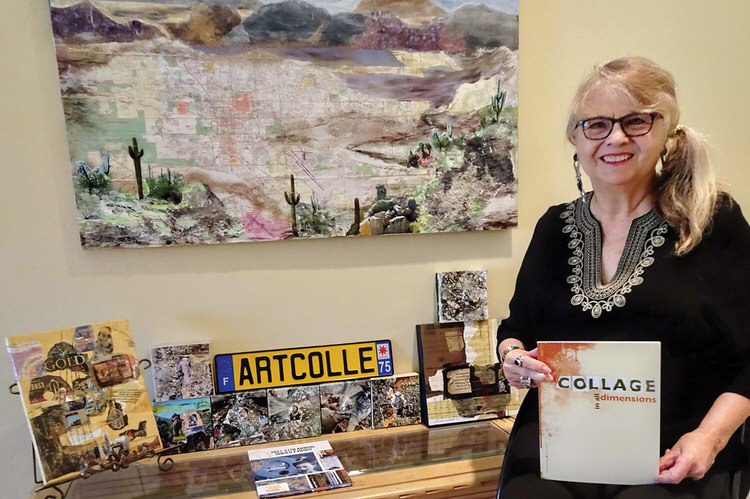
Gretchen Bierbaum shows a collage display in her SaddleBrooke home. (Photo by LaVerne Kyriss)
LaVerne Kyriss
For Gretchen Bierbaum, discovering collage was the perfect blending of her education in both art and test measurements and statistics. “When I was studying art in college, classes in collage and watercolor weren’t even offered. Exploring collage was an aha experience,” she explained. “Collage is more visually exciting than flat painting. It involves any piece of art with a layer glued to its surface.”
This discovery led her to not only explore the art form, but to found the National Collage Society (nationalcollage.com) in 1982, where she still serves as society president. “We formed it as a nonprofit to promote collage, and we host two exhibits each year. The small format show is held each spring, and a juried exhibit is organized each fall,” Bierbaum said. “We’ve been doing this for 40 years and were able to pivot to online events during the pandemic.”
“Collage is the only new fine art medium of the 20th century,” she added. “The first fine art collage was created in France by George Braque in 1912. He and Pablo Picasso shared a studio, and they experimented with adding bits of paper to their paintings. Thus, collage was born,” Bierbaum noted. Because of this French heritage, the names of the collage techniques are in French. “‘Coller,’ the French verb, means ‘to glue,’” Bierbaum explained. “This is where the term “collage” originates.
Collage is all about manipulating your materials,” Bierbaum said. “Cut, tear, and glue. It’s a very tactile art. I also add found objects to my work, creating additional interest. I especially love rusted items.” Bierbaum said she saves everything, noting that collage artists are the original recyclers. “I generally don’t have a specific idea of what I’m going to create. I just start by gathering materials and play with them to see how they interact. All kinds of papers, plastic bags, cigar bands, wine labels, as well as photos, newspaper and magazine illustrations, and artwork, brochures, maps, you name it. They’ve all ended up at one time or another in one of my collages.”
One additional aspect where collage artists must take care is to not violate copyright laws when using found items that are protected. Bierbaum suggests treating magazine pages and other published materials in a way to change them from their original state. “Change it in an original way, thus not violating copyright protection.”
In addition to teaching collage workshops across the country, Bierbaum has also written extensively about collage, creating instruction manuals and highlighting a variety of techniques and approaches. While she no longer actively teaches, Bierbaum said she still enjoys taking classes and being surrounded by artists. “I encourage everyone to go online and watch a YouTube video about an area of interest. Then take an in-person class to get hands-on experience,” she said. “Classes offered by the SaddleBrooke Fine Arts Guild are a great starting point. You can learn in a fun environment, surrounded by people who are also exploring their creative sides.”
When asked to define collage, Bierbaum explained, “All collage is mixed media, but not all mixed media is collage. Collage in the third dimension is called assemblage. All assemblage is sculpture, but not all sculpture is assemblage.”
